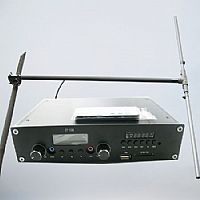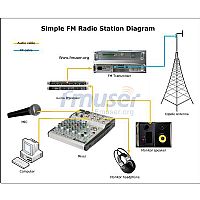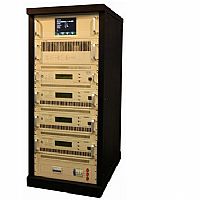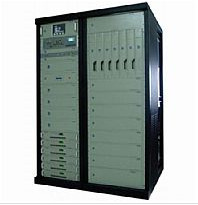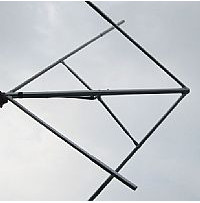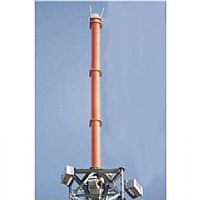Center-focused satellite antenna
Center-focused satellite antennas are generally called positive-focus antennas, or parabolic antennas. Regardless of the depth, the arc of the antenna disk is parabolic. The center-focus antenna is characterized by a perfect circle of the disk, and the LNB is placed at the center of the antenna. The focus antenna is based on its focus. The position can be divided into deep dish and shallow dish.The shorter the focus of the antenna of the same size, the deeper the disc, and the longer the focus, the shallower the disc. If you ask which one is easier to use, each has its own advantages and disadvantages.
When looking for a satellite with an in-focus antenna, you usually only need to know the local receiving elevation angle of the satellite, place the elevation device in the center of the antenna to adjust the elevation, and then use the compass and satellite signal test equipment to easily find the satellite you want. When you are positioning When completed, the center of the disk, the LNB and the 36,000 kilometers of satellites are in a straight line.
| 功能 |
聚焦 |
信号增益 |
防微波干扰 |
货运装柜成本 |
| 深碟 |
短 |
略差 |
好 |
贵 |
| 浅碟 |
长 |
高 |
差 |
普通 |
FRP integrated satellite antenna
The FRP antenna is made of glass fiber, and the inner layer of the fiber is sandwiched with tin foil to reflect the satellite signal. Because the antenna is bulky, the production process is usually made by hand on the mold.
Because this antenna is integrally formed, it can guarantee absolute roundness and accuracy of parabolic surface, completely avoiding the trouble of "side lobe" or "multi-focus" caused by improper combination of combined antennas, due to accuracy Higher than the general combined antenna, the Guben antenna is especially suitable for KU frequency satellite reception that requires high gain.
The integrated antenna is characterized by high gain and uniform antenna gain quality. Different from the combined antenna, the gain quality depends on the construction mood of the engineer. The disadvantage is: because it is integrated, it is used in transportation and high-rise operations. There is a certain degree of difficulty.
FRP antennas can be used to receive C and Ku band satellite signals, and are generally used in cable television systems, TVRO and satellite communication systems related manufacturing industries.
Because FRP antennas are sturdy and durable, about 90% of domestic cable TV systems have used this type of antenna since the early days.
Mesh antenna
With aluminum mesh molding, the accuracy of the structure and curvature of the antenna depends entirely on the shape of the frame, and the combined construction of the antenna will also have a considerable impact on the alignment, so the professional combination technology requirements of the antenna combination technician are very high.
Because this type of antenna is subject to the accuracy of the curvature of the antenna, it is more commonly used in the lower frequency C-band satellite reception. The use of the antenna is mainly cable TV systems, TVRO and personal reception.
Mold stamping iron plate antenna
The iron plate antenna is the one with the highest usage rate in personal reception. It can be divided into defocus integrated molding, center focus integrated molding and center focus multi-piece combination. The iron disk integrated antenna size ranges from 35cm-180cm, and it can generally be used to receive Ku Band satellites, 160cm-180cm antennas can receive C-band satellites depending on the size of the satellite power. The integrated antenna is cheap and easy to install and the signal gain is stable. The only disadvantage is that it is inconvenient to transport more than 100cm. The size of the multi-piece combined antenna of the iron plate is from 160cm- 240cm range, generally suitable for C-band satellite reception, if used to receive Ku frequency, the effect is not ideal.
The iron plate antenna is made of galvanized steel plate and stamped by molds, which can be mass produced, so the price is relatively cheap.
Combined SNC satellite antenna
The SNC satellite antenna uses glass fiber as the raw material, and is formed by mold heating. A layer of stainless steel wire mesh is sandwiched inside to reflect satellite signals.
The SNC antenna can be used to receive C and Ku satellite signals, but when receiving the Ku frequency, you need to pay special attention to whether there is a height difference between the disks and whether the disks are flat when the antennas are combined, because a slight gap will cause the overall efficiency of the antenna to deteriorate.
SNC satellite antennas are usually used in cable television systems and special communication services.
Polar axis chain antenna
The polar axis antenna is also called the synchronous belt antenna. What is the synchronous belt? It is the satellite belt formed by 36,000 kilometers above the equator and circle the earth. The synchronous satellites surround the earth at a distance of 2-3 degrees on the synchronous belt.
And why is the synchronous band antenna also called a polar antenna? We assume that the antenna is located at any latitude in the northern hemisphere. When your antenna has been corrected to be received by all synchronous satellites, the polar axis angle of the antenna at this time is facing the North Star, and the auxiliary elevation angle is Parallel to the earth axis, the timing belt antenna is also called a polar axis antenna.
This antenna is a propulsion system composed of a set of 36V DC stepping motors driving a variable speed gear set and a chain. This system is controlled by a positioner. The locator can output the 36V required by the antenna, and can memorize the current and future satellite addresses received. When the antenna is to be moved to another satellite, just enter the satellite code and the antenna will automatically move to this satellite .
The installation of this system requires considerable reception experience, because the curvature of the synchronization belt seen at different latitudes is different, and it is related to the polar axis angle, azimuth angle and auxiliary elevation angle of the antenna itself. Cannot fully track the synchronization belt
Single push rod polar antenna
The function and operation setting of the single-push pole antenna are the same as the chain pole antenna. The push pole antenna is a kind of polar antenna used in early TVRO. Nowadays, individual receivers in Southeast Asian countries often use this type of antenna to receive 2 -3 satellites.
If a push rod is used to receive satellites in the entire synchronization band, and the antenna will jitter, jump or jam when driving the antenna to receive the extremely east or west satellites (the antenna is now at the position with the highest load, plus the push rod The force is at the very end of the structure, so there will be a phenomenon of insufficient force) So this system has been gradually replaced by a chain drive antenna.
Elevation azimuth drive antenna
Elevation azimuth drive antennas use 1-2 36V elevation stepping motor push rods and a set of 36V azimuth stepping motors. When the antenna is changing to receive satellites, the elevation and azimuth motors will alternately drive, so the antenna's walking route will change Jagged.
Elevation azimuth antennas are not as difficult as polar antennas in the initial installation and setting. At the beginning of the setting, the satellites to be received must be positioned and memorized by the movement of the elevation and azimuth. You only need to enter the code when replacing the satellite in the future.
Since the route the system walks is not completely in line with the synchronous orbit, it will be difficult for the system to detect when a new satellite is sending signals in the synchronous orbit.
Our other product:

